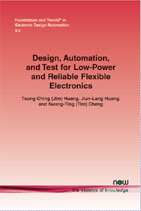Design, Automation, and Test for Low-Power and Reliable Flexible Electronics
By Tsung-Ching (Jim) Huang, Hewlett-Packard Laboratories, Palo Alto, USA, tsung-ching.huang@hp.com | Jiun-Lang Huang, National Taiwan University, Taiwan, jlhuang@cc.ee.ntu.edu.tw | Kwang-Ting (Tim) Cheng, University of California, Santa Barbara, USA, timcheng@ece.ucsb.edu
Abstract
Flexible electronics are emerging as an alternative to conventional Si electronics for large-area low-cost applications such as smart sensors, disposable RFID tags, and solar cells. By utilizing inexpensive manufacturing methods such as ink-jet printing and roll-to-roll imprinting, flexible electronics can be made on low-cost plastic films just like printing newspapers. However, the key elements of flexible electronics, thin-film transistors (TFTs), have slower operating speeds and are less reliable than their Si electronics counterparts. Furthermore, depending on the material property, TFTs are usually mono-type – either p- or n-type – devices. Making air-stable complementary TFT circuits is very challenging or not applicable to most TFT technologies. Existing design methodologies for Si electronics, therefore, cannot be directly applied to flexible electronics. Other inhibiting factors such as high supply voltage, large process variation, and lack of trustworthy device modeling also make designing larger-scale and robust TFT circuits a challenge.
The objective of this article is to provide an in-depth overview of flexible electronics from their applications, manufacturing processes, device characteristics, to circuit and system design solutions. We first introduce the low-cost fabrication methods for flexible electronics, including ink-jet printing, screen printing, and gravure printing. The device characteristics and compact modeling of four major types of TFT technologies, including hydrogenated amorphous silicon (a-Si:H) TFT, polymer organic TFT, self-assembly monolayer (SAM) organic TFT, and metal oxide TFT, will be illustrated. We will then give an overview of digital and analog circuit design from basic logic gates to a microprocessor, as well as design automation tools and methods, for designing flexible electronics. In order to accurately predict the time-dependent degradation of TFT circuits, we describe a reliability simulation framework that can predict the TFT circuits’ performance degradation under bias-stress. This framework has been validated using the amorphous-silicon (a-Si) TFT scan driver for TFT-LCD displays. Finally, we will give an overview of flexible thin-film photovoltaics using different materials including amorphous silicon, CdTe, CIGS , and organic solar cells.
Design, Automation, and Test for Low-Power and Reliable Flexible Electronics
Design, Automation, and Test for Low-Power and Reliable Flexible Electronics provides an in-depth overview of flexible electronics from their applications, manufacturing processes, device characteristics, to circuit and system design solutions. With rapid advances in flexible semiconducting materials, the performance of TFT circuits has been improving significantly and concerns about their ambient stability have been alleviated to a great extent over the past few years. After a brief introduction to flexible electronics, the book highlights its key difference from silicon electronics, and the challenges and opportunities of circuit design for emerging applications such as wearable electronics, personalized healthcare, and flexible displays. While the main focus of the book is on the design, EDA and test issues, it also offers brief technical reviews on TFT technologies, manufacturing methods, and flexible photovoltaics for the purpose of providing a more comprehensive introduction of this emerging field.
